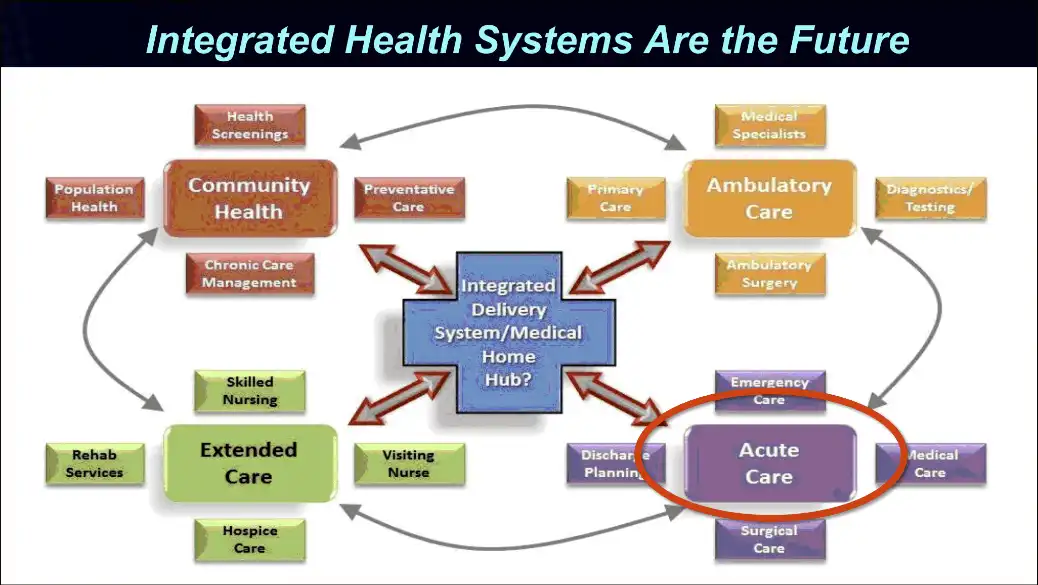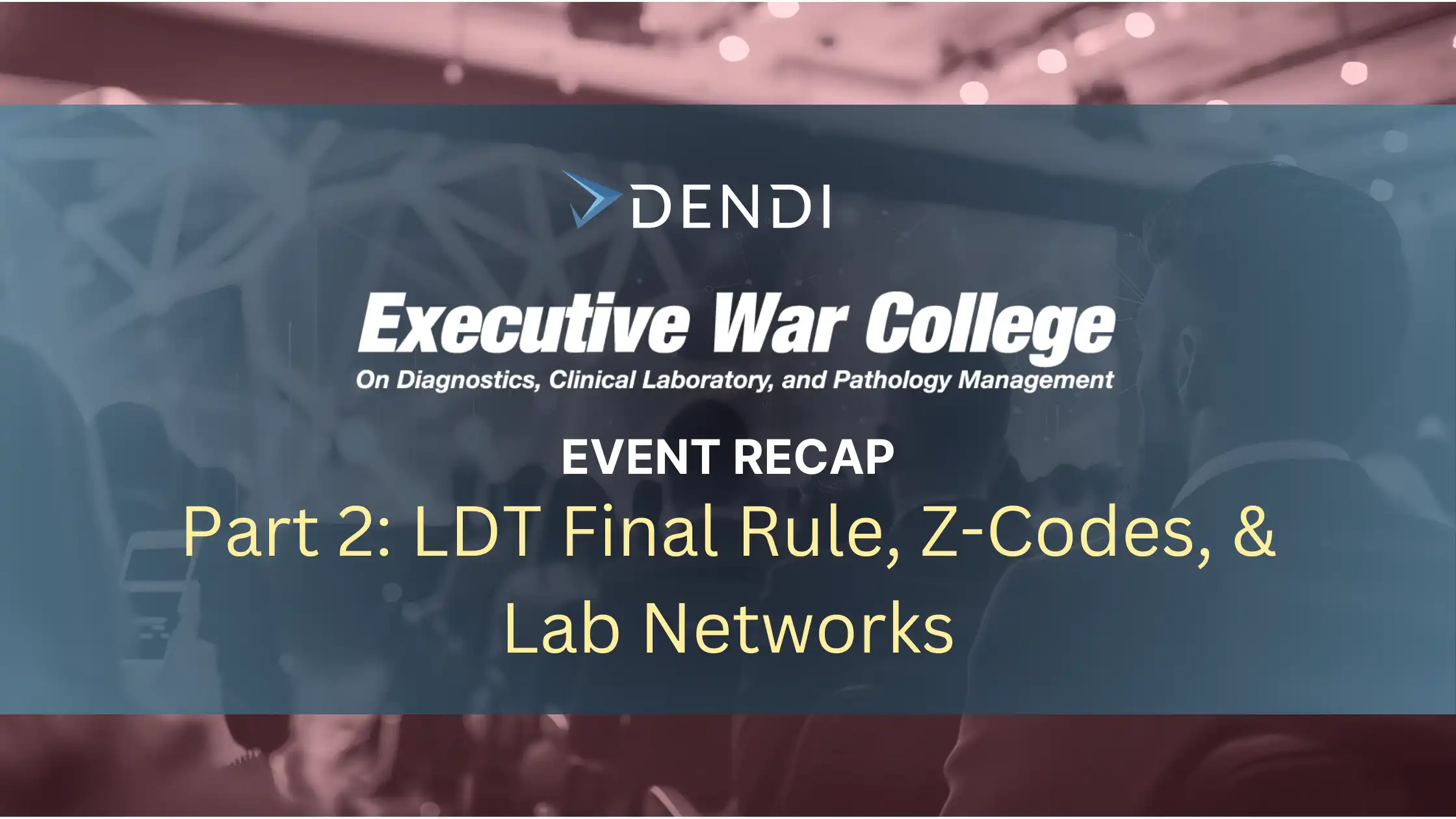Executive War College 2024
Event Recap (Part 2) – LDT Final Rule, Z-Codes, & Integrated Lab Networks
Executive War College is the premier annual conference for clinical diagnostics industry leaders. This year’s event brought together 1054 attendees in New Orleans to meet and strategize over the latest events and trends. This is part 2 of Dendi’s recap of the event, which contains summaries of select sessions and workshops from EWC 2024’s 2-day agenda.
A major highlight was the FDA’s announcement of the final rule on laboratory-developed tests (LDTs), which generated significant buzz as attendees checked in on April 29. Additionally, the conference featured numerous sessions addressing new updates from the ever-evolving healthcare billing landscape, including new requirements for Z-Codes for genetic tests, innovative strategies for capturing appropriate reimbursements like integrated lab networks, and novel revenue cycle management solutions.
Artificial intelligence in clinical applications was the hottest topic this year which received its own dedicated post: EWC2024 Recap Part 1: All Eyes on Clinical A.I.
Surviving & Thriving Past the “Regulatory Perfect Storm”
To wrap up the first day, Robert Michel, Editor-in-Chief of The Dark Intelligence Group, led a general session that gave a comprehensive overview of the trending topics and current events impacting the clinical laboratory industry. The content included the regulatory changes including the FDA’s final rule on laboratory-developed tests (LDTs), new requirements for Z-Codes on genetic tests by private health insurers, and impending updates to the 1992 CLIA regulations. Additionally, key trends such as staff shortages, rising costs, and payer challenges were also discussed, providing valuable insights for laboratory businesses to strategically prepare for the future.
These are key highlights of the general session. Full audio recordings and transcriptions of Executive War College sessions are available from Dark Daily.
The FDA issues final rule to regulate laboratory-developed tests (LDTs)
- The FDA’s LDT regulations are effective from May 6, 2024.
- The rule is detailed in a 538-page document and is expected to face litigation.
- The reclassification of high-risk IVDs to moderate-risk will allow for easier approval through the 510(k) pathway, reducing the burden on laboratories.
- Dark Daily’s June 10th edition of the Dark Report contains additional insights and interviews with industry experts regarding the LDT Rule.
Private health insurers are requiring Z-Codes for genetic tests
- UnitedHealthcare mandates that claims submitted for genetic tests have Z-Codes, effective June 1, 2024.
- This policy may influence other major health insurers to adopt similar requirements.
Updates are coming for CLIA Act
- CLIA regulations which have been largely unchanged since 1992 are being revised to reflect modern technologies and practices.
- Proficiency testing (PT) updates include more PT challenges, new analytes for PT, and clarification that a nursing degree is no longer considered sufficient training to perform high-complexity testing.
- New updates are expected to be made public within the next 12 to 24 months, addressing current advancements in laboratory testing.
Key Trends and Challenges
- Staff Shortages and Rising Costs: Chronic labor shortages and rising salaries are affecting all skill levels and positions in labs.
- Supply Chain Issues: Increasing costs for automation, analyzers, test kits, and consumables due to unpredictable supply chains.
- Payer Challenges: Health insurers are increasingly denying lab test claims, exacerbated by the explosion of molecular and genetic tests.
Strategic Takeaways
- Adapt to Value-Based Reimbursement: The shift from fee-for-service to value-based reimbursement models presents opportunities for labs to demonstrate their value through improved patient outcomes and cost savings.
- Inflation and Economic Pressures: Inflation and high interest rates are expected to continue, affecting reimbursement rates and increasing operational costs.
- Integrated Health Systems are the Future: The trend towards integrated health systems and hospital consolidation will impact lab operations and strategic planning. Integrated delivery networks and hospitals are losing money as fewer patients are being treated in inpatient settings and value-based reimbursement continues to increase over fee-for-service arrangements.

Robert Michel’s general session provided a comprehensive overview of the impending regulatory changes and current market trends affecting clinical laboratories. To gain deeper insights and practical strategies attendees had the chance to attend focussed sessions at the conference that delved deeper into specific topics, offering detailed analyses and actionable guidance to help labs navigate the evolving landscape successfully.
Timing and Implications of FDA LDT Rule; Reforms to CLIA Regulations; Wider Use of Z-Code by Payers
Led by William Morice (President & CEO of Mayo Clinic Laboratories), Tim Stenzel (CEO of Grey Haven LLC), Lale White (Executive Chair & CEO of XiFin, Inc.), and Gabriel Bien-Willner (Chief Medical Officer of Palmetto GBA), this panel discussion addressed the implications of the FDA’s new rule on Laboratory Developed Tests (LDTs), reforms to CLIA regulations, and the wider use of Z-Codes by payers, providing insights into the evolving regulatory landscape and its potential impact on the clinical laboratory sector.
Key Aspects of the FDA’s Final Rule on LDTs
The FDA’s final rule on LDTs aims to enhance transparency and ensure a minimum quality standard for these tests, especially those used in clinical studies targeting rare genetic conditions. A pilot program was initiated to collect data on tests used in clinical trials without requiring immediate authorization, helping to understand their performance characteristics.
This rule also introduces phased compliance requirements over several years, mandating labs to adhere to medical device reporting, labeling, registration, listing, and investigational use requirements by specific deadlines. The ultimate goal is to streamline the regulatory process and facilitate the development and approval of new tests.
Reclassification of High-Risk IVDs
In addition to these changes, the FDA is actively reclassifying certain high-risk In Vitro Diagnostic Devices (IVDs) to moderate-risk, aiming to ease the regulatory burden on manufacturers. This reclassification allows these tests to seek marketing authorization through the less rigorous 510(k) clearance pathway rather than the pre-market approval (PMA) pathway.
The FDA believes this move will encourage more manufacturers to develop these tests, increasing competition and access to essential diagnostics. This effort includes reclassifying most infectious disease and companion diagnostic IVDs, which could significantly reduce the regulatory burden on laboratories once LDTs are regulated as IVDs.
Compliance with Raw Reagent and Kit Use Regulations
The session also addressed the use of raw reagents and kits in test development, emphasizing the need for developers to comply with specific regulations and integrate these reagents into their quality systems. A recent FDA warning letter highlighted the importance of adhering to these guidelines. Furthermore, the panel discussed the FDA’s participation in the International Medical Device Regulators Forum (IMDRF), which aims to harmonize device regulations globally. This includes a single audit program where manufacturers undergo one audit for multiple countries, simplifying the compliance process and ensuring international standards are met.
Implications for Lab Business Owners
For lab business owners, these regulatory changes underscore the need to stay informed and adapt to new compliance requirements. The FDA’s efforts to streamline the approval process and reclassify high-risk IVDs are poised to reduce regulatory burdens, enhance competition, and increase access to critical diagnostic tests. However, ensuring compliance with new guidelines and participating in international harmonization efforts will be crucial for laboratories to navigate this evolving landscape successfully.
MolDx and Z-identifier Codes: Why and How and the Future
In this session, Gabriel Bien-Willner, MD, PhD, FCAP, Chief Medical Officer of Palmetto GBA, addressed the complexities of molecular test claims which has necessitated the Medicare Molecular Diagnostic Services (MolDx) Program and Z-identifier code requirements. He detailed the MolDx process requirements and introduced the DEX Registry’s role in bringing more clarity to molecular testing to ensure appropriate reimbursement.
MolDx Program Purpose
The Medicare MolDX Program was established in 2012 by CMS to to create payor controls for molecular diagnostics. It aims to streamline the coverage, coding, and pricing of molecular pathology services. It has been implemented across 28 states and coordinates Local Coverage Determination (LCD) and Local Coverage Article (LCA) development with participating Medicare Administrative Contractors (MACs).
CMS MolDX Policy and Process
For coverage and claims processing described in Molecular Diagnostic Tests Policy (LCD L35025), molecular diagnostic test claims require a Z-identifier that is registered in the DEX registry, where each test is assigned a unique Z-identifier. This identifier facilitates automated claims processing by providing detailed information about the test. Additionally, tests must undergo a Technical Assessment (TA) to ensure they meet criteria for analytical validity (AV), clinical validity (CV), and clinical utility (CU). These assessments verify that the tests are accurate, clinically relevant, and useful for patient management. See the CMS guidelines here.
Palmetto GBA’s DEX Registry Platform
The registry is a free-to-use comprehensive database where providers can register their molecular diagnostic tests. It assigns unique Z-codes to each test, facilitating detailed and automated claims processing. The registry stores essential information such as test name, provider details, methodology, analytes measured, intended use, and relevant CPT and ICD-10 codes. This platform ensures transparency and efficiency, enabling payors to quickly determine the appropriateness, quality, and clinical value of tests. Initially designed for Medicare, the DEX registry is now also being utilized by commercial payors to streamline billing and reduce discrepancies in claims adjudication. See additional information about the DEX Registry.
Takeaways for Labs
Participating in the MolDX program offers significant benefits for lab owners, particularly in streamlining billing and claims processing. Using Z-identifiers will help labs ensure that their tests are accurately billed and processed, reducing delays and discrepancies in reimbursement. Undergoing technical assessments for analytical, clinical validity, and utility will help labs demonstrate the reliability and necessity of their tests, thereby improving their chances of coverage and reimbursement.
Additionally, leveraging the DEX Registry is crucial for facilitating automated claims adjudication, which makes the process more efficient and transparent. The DEX Registry allows labs to easily communicate the details and validity of their tests to payors, enhancing trust and clarity. Furthermore, understanding that MolDX methodologies are being adopted by commercial payors (such as UnitedHealthcare as of April 1, 2024), labs can open new opportunities to extend their services beyond Medicare, potentially increasing their market reach and revenue. By aligning with these practices, labs can ensure compliance, improve operational efficiency, and expand their business in the evolving landscape of molecular diagnostics.
Emerging National Lab Networks Automate Reference Test Ordering/Resulting and Help Labs Generate New Revenue
This session featured Steven Serota (President and CEO of Wisconsin Diagnostic Laboratories and Atalan), Steve Box (Global Business Development Director at Labgnostic Inc.), Scott Liff (Owner and Principal of LiffLabs), Mehdi Maghsoodnia (CEO of 1health.io), and Tim Pletcher (Executive Director of the Michigan Health Information Network). Together, they emphasized the importance of embracing innovative network models to meet the evolving demands of healthcare delivery. They also provided insights into how clinical laboratories can leverage technology to enhance efficiency and generate new revenue streams.
Partnership and Network Building
The panel highlighted the importance of forming strategic partnerships with payers to incentivize local providers to close care gaps. The current model relies heavily on national labs like Quest and Labcorp, which often results in low success rates due to the inconvenience for patients. Instead, a hyper-local approach was suggested, where local labs are empowered and incentivized to close care gaps. Elevance Health (Anthem) has recently partnered with 1health to create such a network, allowing local labs to serve their communities more effectively and get paid for their services. This model aims to improve patient compliance and healthcare outcomes by making testing more accessible.
Challenges and Solutions
One of the primary challenges discussed was the dominance of large national labs and the decentralized nature of hospital labs, which creates inefficiencies and silos. Tim Pletcher noted that rolling out a standardized order entry mechanism across various labs is difficult due to the entrenched systems and market dominance of large players like Quest. Additionally, the technological infrastructure in many labs is outdated, making it hard to implement modern solutions.
Mehdi Maghsoodnia compared this situation to the early days of mobile technology, explaining that just as mobile applications could not run on landline phones, modern lab operations require a new tech stack. Investing in a modern network infrastructure rather than continually upgrading isolated systems (LIS) is crucial for enabling seamless, hyper-local healthcare services.
Technological Innovations
The 1health platform was presented as a solution to many of these issues. This platform supports automated workflows and integrations that make it easier for labs to manage their operations. It allows for seamless data transmission and real-time monitoring of tasks, enhancing operational efficiency.
Steve Box shared an anecdote about visiting a lab where orders and results were processed manually, highlighting the inefficiency and the need for automation. He stressed that the technology to automate these processes is available, and the industry must adopt it to improve efficiency.
Operational and Governance Issues
Operational challenges, such as manual processing and lack of standardized systems, were discussed extensively. Tim Pletcher pointed out that many labs operate in silos, which hinders the standardization and scalability of lab operations. The panel agreed that there is a need for governance frameworks that encourage collaboration and synergy among labs.
The discussion also touched on the financial pressures faced by labs and the need for sustainable business models. Scott Liff mentioned that the pandemic has made labs more aware of the need for operational sustainability and collaboration to navigate financial challenges.
Strategic Advice for Labs
The panel provided strategic advice for labs considering joining networks. They emphasized the importance of understanding the intrinsic and financial value that labs bring to the healthcare ecosystem. Labs should explore various network options and choose those that align with their needs and goals.
Mehdi Maghsoodnia commented that this is similar to the early internet days, where building the infrastructure was key to enabling new applications and services. He also mentioned that changing a LIMS is a waste of money.
“Changing LIMS does not create a network. [Labs] have to invest in networks – and investment in networks is lacking. Budgets are going into endpoint systems that will continue to be legacy by definition because they’re not designed to interface with systems – they’re designed to interface with lab equipment and lab equipment is not changing. Trying to get your LIMS to do things it was not designed to is not a software strategy. It’s a complete waste of money. The LIMS is not the problem. You don’t have a network.”
– Mehdi Maghsoodnia
(See our response in Dendi’s Takeaways below)
Audience Q&A and Conclusion
During the Q&A session, an audience member raised concerns about integrating small physician offices into lab networks, which often lack IT support. Mehdi Maghsoodnia responded that payer incentives are crucial for encouraging providers to join networks. Tim Pletcher added that existing health information exchanges (HIEs) can help deliver results to small providers and reduce the onboarding burden.
The session concluded with the panelists reiterating the importance of investing in modern network infrastructure to drive innovation and improve lab operations. Tim Pletcher suggested that independent labs and hospital labs have the potential to create a more innovative and responsive network model compared to large, consolidated entities. Steve Box emphasized the need for collaboration and the use of new technologies to overcome current challenges.
The session highlighted the transformative potential of national lab networks in automating processes and generating new revenue. It called for strategic partnerships, technological innovation, and collaborative governance to overcome existing challenges and drive the lab industry forward.
Dendi’s Takeaways
Many points made during EWC have validated Dendi’s mission to advance clinical diagnostics. Mehdi Maghsoodnia suggests that when the goal is to develop a lab network, switching to a legacy LIMS that is incapable of modern interfaces is a waste of resources. We totally agree- it’s why Dendi LIS was designed to interface with all types of systems such as 1health via a modern API. It’s true that lab networks need more development, but that cannot be accomplished until labs are operating on systems that are capable of being integrated into networks. The legacy LIS and LIMS that many labs are operating on today are hindering that progress. So it’s not that investing into switching systems is a waste of money, but switching to the wrong systems is.
With the healthcare industry increasingly motivated to create a seamless care continuum, health systems are integrating vertically by acquiring outpatient services. Dendi enables diagnostic labs to integrate with Integrated Delivery Networks (IDNs) by providing a platform that facilitates easy healthcare information exchange, supporting this trend towards vertical integration. Dendi customers have already formed their own lab networks, like managed service organizations, to service patients in senior living, assisted living, and long-term care facilities. Our customers are many proofs of concept that a modern LIS does enable the opportunity for lab networks to thrive.
Because Dendi is a single cloud-native platform, it facilitates business development opportunities, allowing our customers to collaborate and create their own networks. Independent reference labs benefit significantly when part of a network, offering more advantages than operating alone. With rapid innovations in diagnostics, the need for easily deployable and secure healthcare data exchange is critical.
Labs need to stay up to date on rapidly changing claims requirements. Dendi’s frequent and instant deployment of updates can help labs stay current by enabling support for new requirements like medical necessity data and billing codes like Z-identifiers as soon as they’re announced to keep revenue cycle management processes streamlined.
Building national lab networks and healthcare networks requires modern, cloud-native IT infrastructure to enable healthcare information exchange between labs and multiple systems like hospitals, EHRs, and outpatient services. Dendi’s product was developed to handle all types of data integration protocols, including older HL7 protocols and modern API standards, ensuring that labs can still be compatible with the current common standards and lead the charge for the advancement of healthcare networks into the future.
Learn more at www.dendisoftware.com.


